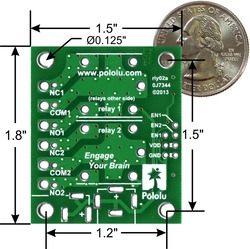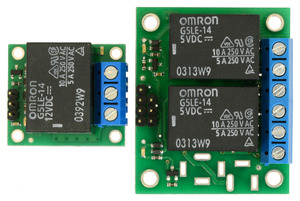
Pololu Basic 2-Channel SPDT Relay Carrier for "Sugar Cube" Relays
Tutti i prezzi sono IVA inclusa
Pololu’s basic 2-channel relay carrier board makes it easy to incorporate two “sugar cube”-style power relays into your electronics project. Integrated MOSFETs allow the relays to be controlled with low-current digital inputs, an indicator LEDs show when the relays are activated. The control pins have a 0.1″ spacing compatible with standard solderless breadboards and servo cables, and the switch pins are available for use with 5mm-pitch terminal blocks or 0.2″-spaced pins.
 |
Overview
The Pololu basic 2-channel relay carrier modules make it easy to control two single-pole, double-throw (SPDT) power relays that have the common “sugar cube” pinout and footprint. This product is just the carrier board PCB assembled with all of its surface mount components, including MOSFETs for controlling the relays, indicator LEDs, and flyback diodes; it does not include relays or connectors. This board is also available with 5 V and 12 V power relays (assembled or as a partial kit):
Alternatives available with variations in these parameter(s): voltage partial kit? Select variant…
The carrier board routes the relay control pins to 0.1″-spaced pins compatible with standard solderless breadboads and female servo cable connectors. The relay switch pins are routed to a set of large pads intended for use with two 3-pin 5mm-pitch terminal blocks and a set of smaller pads with a 0.2″ pitch, making them compatible with 0.1″ perfboards. The carrier board has four mounting holes that work with #4 or M3 screws.
Advantages over similar products
- Compact layout
- LEDs to indicate coil actuation
- Zener diodes for fast current decay on relay coils
- Specification of electrical routing clearance rules on relay switch nodes
Comparison to the single-channel version
 |
Our basic relay carrier boards are available in single-channel and dual-channel versions. The single-relay carrier is less than half the size of the 2-channel carrier (due in part to its smaller mounting holes and lack of barrel jack footprints), so it might be more appropriate to use two single-channel boards instead of one 2-channel board in some space-constrained applications. The following table shows some of the key differences between the two versions:
| Voltage options | Board size | Mounting hole size | # of channels | DC power jack option | |
|---|---|---|---|---|---|
| Single-relay carrier | 5 V and 12 V | 1.15″ × 1″ | 0.086″ (#2 or M2) | 1 | no |
| Dual-relay carrier | 5 V and 12 V | 1.5″ × 1.8″ | 0.125″ (#4 or M3) | 2 | yes |
Using the relay modules
 |
The switch portion of the relays are accessible on one side of the board while the control pins are routed to the other. The relay coils are powered by supplying the appropriate coil voltage for your specific relays across the VDD and GND pins, and they are activated by digital high control signals on their respective EN pins. The control signals are fed directly to the BSS138 N-channel MOSFETs, which in turn actuate the relay coils when the signal voltage exceeds approximately 2.5 V, up to a maximum of 20 V (see BSS138 datasheet (92k pdf) for details). The control pins are arranged to allow for several connection options: a single 1×4 cable can be used to supply coil power and the two control signals, or two 1×3 cables (such as servo cables) can be used side-by-side (one for each relay).
The relay switch terminals COM (common), NO (normally open), and NC (normally closed) are routed on the PCB with a minimum clearance of 60 mils (1.5 mm) from other copper and the edges of the board, though manufacturing variations in the board edges can make those distances slightly lower.
In most applications, the current and voltage ratings for the module will match the ratings of the relay used. Maximum current, maximum voltage, and life expectancy are interdependent; we therefore recommend careful examination of your relay’s datasheet.
Warning: This product is not designed to or certified for any particular high-voltage safety standard. Working with voltages above 30 V can be extremely dangerous and should only be attempted by qualified individuals with appropriate equipment and protective gear.
Optional DC barrel jack
 |
The carrier board makes it possible to optionally power the relays from a DC barrel jack (not included). The DC barrel jack can be placed in three configurations, two of which are shown in the pictures above (the jack can also be installed in one configuration on the bottom side of the PCB).
Schematic diagram
 |
Pololu basic 2-channel SPDT relay carrier schematic diagram. |
|---|
This schematic is also available as a downloadable pdf (144k pdf).







